Diascia Plant: Grow & Care for Twinspur
Written by Iris
Jul 29 2021
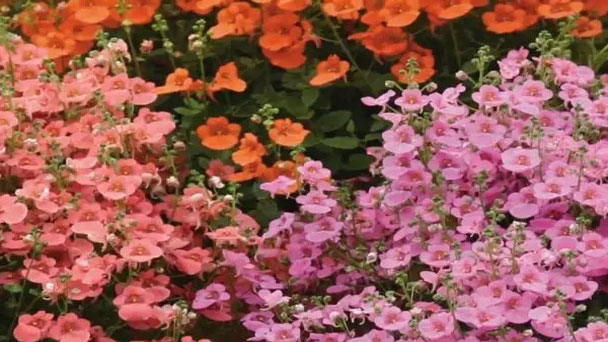
Diascia (Twinspur), with peculiar flower shapes, blooms from spring to autumn. The colors of Diascia (Twinspur) are orange, pink, white, etc. The branches are arched and drooping. Diascia (Twinspur) can be sown by seeds or branch cuttings to propagate. Diascia (Twinspur) especially like sufficient light conditions and are maintained in full daylight.
Check the plant label for suggested spacing. Crowding plants can result in fewer blooms and weak growth as the plants compete for light. Exceptions to this might be regions with a short growing season, shade plantings which tend to grow slower and fill in less quickly, or a need to fill an area with color quickly such as for a special event or if planning to entertain guests outdoor.
Vining annuals require vertical space to grow, so provide a trellis, fence, wall or other structure that allows the plant to grow freely and spread.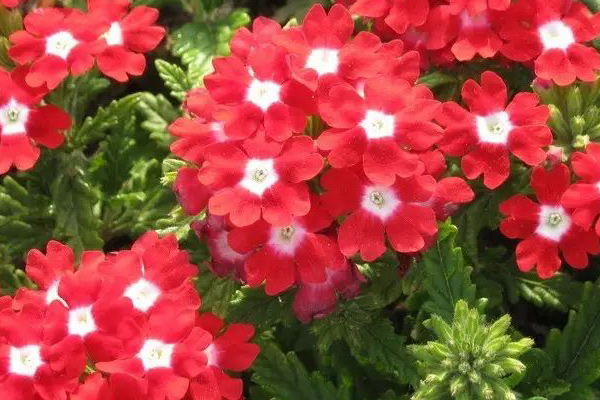
Seeds can be sown directly in the garden.
However, it is best to prep the seeds indoors at least 8 to 10 weeks before the last frost.
The prepped seeds should be planted outdoors once the soil has started warming up and the temperature reaches 60° degrees Fahrenheit (15° C).
The ideal temperatures maintained should be between 60° – 65° degrees Fahrenheit (15° – 18° C) until the germination process starts.
The germination of this plant requires sufficient light.
Therefore, it is best to firmly press the seeds at the surface of the soil, instead of covering it.
Ensure the soil stays moist for the roots to establish.
The germination process typically takes around two weeks.
You can plant directly in the ground starting in May, or transplant your seedlings to garden boxes and pot arrangements.
Preparing diascia cuttings is best done in spring or in fall.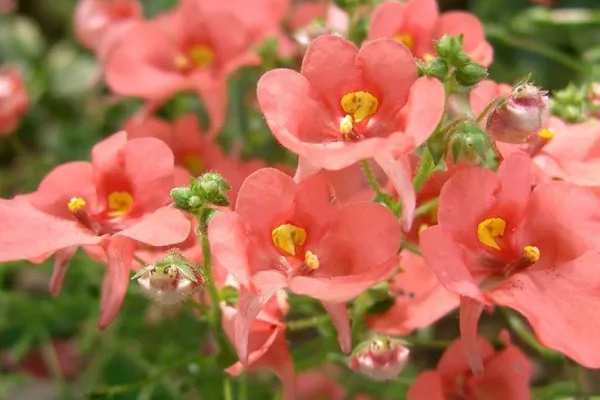
Soil
Diascia prefers a slightly acidic soil pH. Something between 6.0 and 6.5 seems to be ideal. The soil should be fertile and well-drained.
Different plants have different water needs. Some plants prefer staying on the dry side, others like to be consistently moist. Refer to the plant label to check a plant’s specific requirements.
Ideally water should only be applied to the root zone - an area roughly 6-12” (15-30cm) from the base of the plant, not the entire plant. A soaker hose is a great investment for keeping plants healthy and reducing water lost through evaporation. Hand watering using a watering wand with a sprinkler head attached is also a good way to control watering. If the garden area is large, and a sprinkler is necessary, try to water in the morning so that plant foliage has time to dry through the day. Moist foliage encourages disease and mold that can weaken or damage plants.
To check for soil moisture use your finger or a small trowel to dig in and examine the soil. If the first 2-4” (5-10cm) of soil is dry, it is time to water.
Diascia is somewhat frost-tolerant and can be kept going well into the fall. If you’re willing to move your pots into the garage whenever a hard frost threatens, they will last even longer.
Pruning
Pinch-out the growing tips of young plants to encourage more bushy growth. Deadhead regularly to extend the flowering period.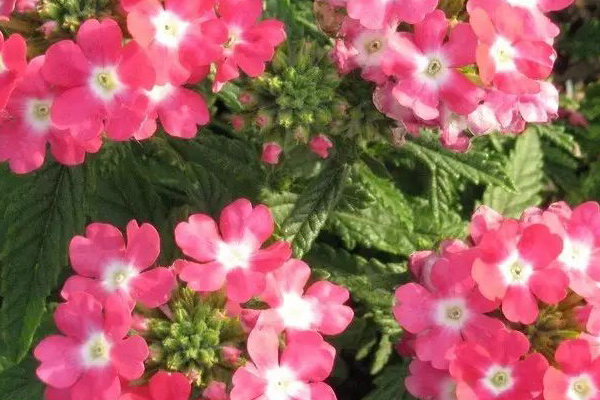
This Diascia has shiny foliage and coral blooms on 10-inch-tall plants.
'Flirtation Orange' Diascia
'Flirtation Orange' is an extremely floriferous variety with great heat tolerance. It practically covers itself in orange blooms and grows 1 foot tall and 2 feet wide.
'Flirtation Pink' Diascia
This variety bears masses of pink flowers on a heat-tolerant plant that gets 12 inches tall and 20 inches wide.
'Sun Chimes Coral' Diascia
Diascia 'Sun Chimes Coral' bears coral-pink blooms on spreading, 12-inch-tall plants.
'Whisper White' Diascia
'Whisper White' bears pure-white flowers on 10-inch-tall plants.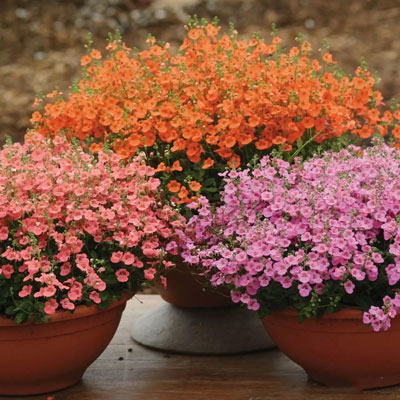
How to Choose and Prepare a Planting SiteHow to Grow Diascia (Twinspur) How to Care for Diascia (Twinspur) Varieties of Diascia (Twinspur) Diascia (Twinspur) FAQ
How to Choose and Prepare a Planting Site
Diascia basket varieties can decorate any room as well as a terrace, loggia, balcony, veranda or other areas. For planting shrubs using containers or window boxes, alternatively, you can use the suspension structures, namely, baskets or pots. The flower looks great in large pots.Check the plant label for suggested spacing. Crowding plants can result in fewer blooms and weak growth as the plants compete for light. Exceptions to this might be regions with a short growing season, shade plantings which tend to grow slower and fill in less quickly, or a need to fill an area with color quickly such as for a special event or if planning to entertain guests outdoor.
Vining annuals require vertical space to grow, so provide a trellis, fence, wall or other structure that allows the plant to grow freely and spread.

How to Grow Diascia (Twinspur)
Steps Diascia (Twinspur) for Propagation with Seeds
Sowing is best when performed in spring (March and April), in a sheltered place if temperatures don’t yet exceed 60°F (15°C).Seeds can be sown directly in the garden.
However, it is best to prep the seeds indoors at least 8 to 10 weeks before the last frost.
The prepped seeds should be planted outdoors once the soil has started warming up and the temperature reaches 60° degrees Fahrenheit (15° C).
The ideal temperatures maintained should be between 60° – 65° degrees Fahrenheit (15° – 18° C) until the germination process starts.
The germination of this plant requires sufficient light.
Therefore, it is best to firmly press the seeds at the surface of the soil, instead of covering it.
Ensure the soil stays moist for the roots to establish.
The germination process typically takes around two weeks.
You can plant directly in the ground starting in May, or transplant your seedlings to garden boxes and pot arrangements.
Steps for Diascia (Twinspur) Propagation with Stem Cuttings
This is a plant that is often successfully multiplied with the most common method for preparing cuttings.Preparing diascia cuttings is best done in spring or in fall.
- Collect cuttings about 4 to 6 inches (10 to 15 cm) long, ideally on stems not bearing flowers.
- Pinch off lower leaves to keep only the highest pair of leaves.
- It is possible to dip the cuttings in powdered rooting agents, if you have any.
- Plant the cuttings in special cutting soil mix.
- Water regularly.
- Transfer the cuttings to a spot that's out of the cold in winter, so that they stay at 50 to 60°F (10 to 15°C).

How to Care for Diascia (Twinspur)
Light
You'll get the most blooms by keeping your diascia in full sun, but in really hot weather, the plant will do best when grown in partial shade, particularly afternoon shade.Soil
Diascia prefers a slightly acidic soil pH. Something between 6.0 and 6.5 seems to be ideal. The soil should be fertile and well-drained.
Water
New plantings should be watered daily for a couple of weeks. After that, depending on the weather and soil type, watering can be adjusted to every two or three days. Clay soils hold moisture longer than sandy soils, so expect to water more frequently in sandy settings.Different plants have different water needs. Some plants prefer staying on the dry side, others like to be consistently moist. Refer to the plant label to check a plant’s specific requirements.
Ideally water should only be applied to the root zone - an area roughly 6-12” (15-30cm) from the base of the plant, not the entire plant. A soaker hose is a great investment for keeping plants healthy and reducing water lost through evaporation. Hand watering using a watering wand with a sprinkler head attached is also a good way to control watering. If the garden area is large, and a sprinkler is necessary, try to water in the morning so that plant foliage has time to dry through the day. Moist foliage encourages disease and mold that can weaken or damage plants.
To check for soil moisture use your finger or a small trowel to dig in and examine the soil. If the first 2-4” (5-10cm) of soil is dry, it is time to water.
Temperature and Humidity
Diascia prefers cooler temperatures, and it flowers best in the spring and fall. If your plants start to fade in the heat, cut them back to a few inches and keep them watered. They will perk back up when it cools off.Diascia is somewhat frost-tolerant and can be kept going well into the fall. If you’re willing to move your pots into the garage whenever a hard frost threatens, they will last even longer.
Fertilizer
Feed the plant is relatively rare, only 1 time in 30 days. To do this, use a solution of fertilizers for flowering garden plants, while its concentration should be quite weak. If the soil is too many nutrients, the bushes may not bloom at all. In addition, in the too fertile soil, there is an elongation of the shoots of Diascia, which it loses its decorative effect.Pruning
Pinch-out the growing tips of young plants to encourage more bushy growth. Deadhead regularly to extend the flowering period.
Pests and Diseases
Diseases are not a significant issue for the diascia plants unless they experience a highly wet season. The major pest issue for these plants is slugs and snails. It is best to lift the plants from the ground to avoid the pests or use a mild spray to eliminate them.
Varieties of Diascia (Twinspur)
'Coral Belle' DiasciaThis Diascia has shiny foliage and coral blooms on 10-inch-tall plants.
'Flirtation Orange' Diascia
'Flirtation Orange' is an extremely floriferous variety with great heat tolerance. It practically covers itself in orange blooms and grows 1 foot tall and 2 feet wide.
'Flirtation Pink' Diascia
This variety bears masses of pink flowers on a heat-tolerant plant that gets 12 inches tall and 20 inches wide.
'Sun Chimes Coral' Diascia
Diascia 'Sun Chimes Coral' bears coral-pink blooms on spreading, 12-inch-tall plants.
'Whisper White' Diascia
'Whisper White' bears pure-white flowers on 10-inch-tall plants.

Diascia (Twinspur) FAQ
Is Diascia (Twinspur) a hardy?
Only Diascia fetcaniensis is hardy and can stay in the groung in winter. This flower offers a magnificent bloom all summer long, and will be at its best in the sun and in fertile, well drained soil.Is Diascia (Twinspur) a trailing plant?
Diascia is a tender South African perennial typically grown as an annual, popular in patio bedding and container displays, especially hanging baskets. Diascia 'Divara White' bears masses of pure white blooms on trailing plants, all summer long.How big do Diascia grow?
Most diascia species are short-growing, straggling plants, reaching no more than 30–45 centimetres (12–18 in) in height, although Diascia rigescens can reach 60 cm (24 in), and the rather similar D.Is Diascia annual or perennial?
A pretty little short-lived perennial, that is usually grown as an annual in the UK. A very useful free flowering plant, especially when grown in full sun. Its dainty twin-spurred flowers give it its common name, twinspur.
Latest Updated
- Benefits of Bugleweed - 7 Science-backed Health Benefits
- Bugleweed Dangers & Side Effects - Is It Poisonous?
- How to Plant Evergreen Trees - What You Should Know
- When to Plant Evergreens - Grow Guide for Evergreen Trees
- 12 Wonderful Evergreen Shrubs for Your Garden
- 12 Popular Evergreen Plants with Pictures for Beginners
- When And How To Prune A Lilac Bush Like a Pro
- How to Grow & Care for Lilac Vine (Hardenbergia Violacea)
- Japanese Lilac Tree (Syringa Reticulata) Care & Propagation Guide
- Shumard Oak Pros and Cons - What to Know
Popular Articles
- Winter maintenance of Antirrhinum Majus
- How to Grow Terminalia Mantaly Tree
- How to Grow and Care for Crossostephium Chinense
- How to grow Antirrhinum Majus in spring
- Peristeria Elata (Dove Orchid) Profile: Info & Care Guide
- Underwatered Snake Plant (Sansevieria Trifasciata) - Signs And How To Fix
- How to Care for Brazilian Jasmine Plant (Mandevilla Sanderi)
- How to Grow & Care for Graptopetalum Purple Delight in Summer
- Rosa Chinensis (China Rose): Plant Growing & Care Tips
- How to Care for Baby Sun Rose (Aptenia Cordifolia)